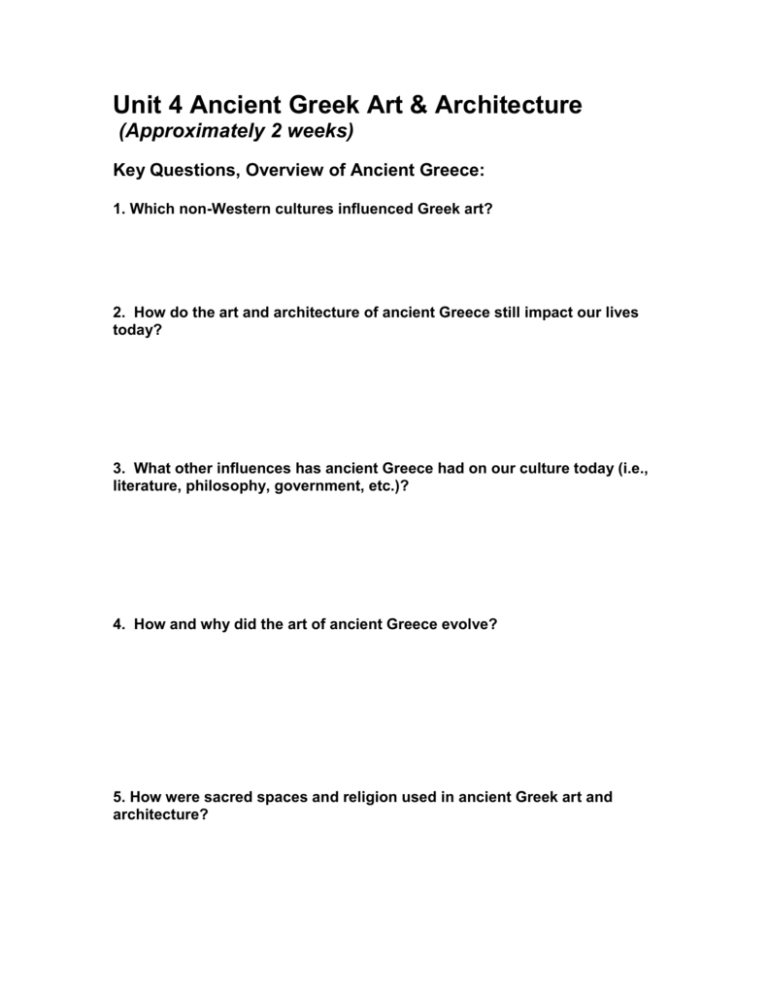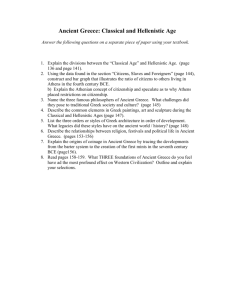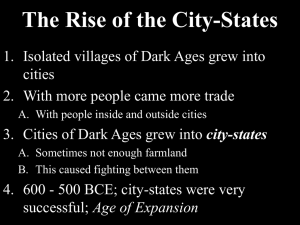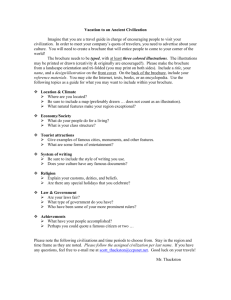unit4guide.doc - Doral Academy Preparatory
advertisement

Unit 4 Ancient Greek Art & Architecture (Approximately 2 weeks) Key Questions, Overview of Ancient Greece: 1. Which non-Western cultures influenced Greek art? 2. How do the art and architecture of ancient Greece still impact our lives today? 3. What other influences has ancient Greece had on our culture today (i.e., literature, philosophy, government, etc.)? 4. How and why did the art of ancient Greece evolve? 5. How were sacred spaces and religion used in ancient Greek art and architecture? Cultural Chronology of Ancient & Classical Greece Years Greece Around World 1100-750 BCE Geometric 725-600 BCE Orientalizing 600-480 BCE Archaic Period Homer’s Iliad Odyssey Corinthian Black Figure Doric/Ionic Orders, Kouros 480-450 BCE 450-400 BCE 400-320 BCE 320-30 BCE Kritios Boy, Sophocles Parthenon, Polykleitos Praxiteles, Plato Pergamon, Laocoon Olmec Pyramids Assyria falls! Babylon, Siddhartha/buddha Persepolis Early Classic High Classic Late Classic Hellenistic Terracotta Warriors, Xian Ceramics Chronology of Ancient & Classical Greece Type Ceramics Geometric Orientalizing (Corinthian) Black-figure Ware Red-figure Ware White Ground Cultural Period Geometric Orientalizing (Persian influence) Archaic Archaic Classical Geometric Period (flashcard) 1. Funerary Vase, from the Dipylon Cemetery, Athens, c. 750 BCE Terra-cotta 42: high Orientalizing Period (flashcard) 1. Corinthian Olpe (vase), from Corinth, Athens, c. 6000 BCE ceramic blackfigure 11: high Archaic Period (600-480 BCE) 1. Temple of Hera, Paestum, Italy c. 550 BCE 2. Dying Warrior, from east pediment of the Temple of Ahaiai, Aegina, c. 500 BCE, marble, life size. 3. Kouros, c. 600 BCE 4. Kouros, from Anavysos cemetery, c. 530 BC marble/paint, 6’4” 5. Kore, from Chios, 520 BCE 5. Euphronius, Death of Sarpedon, red figure decoration on a calyx krater, c. 515 BCE, ceramic, 18”, MET NY Vocabulary, Archaic Period Archaic smile Krater Kouros/Kore Early Classical Period (480-450 BCE) (Severe style) Key Concept: How are Greek Classic figures Platonic in form? (See Plato’s Allegory of the Cave) 1. Kritian Boy/Kritios boy, c. 480 BCE, Marble, 46” 2. Myron, Discus Thrower, c. 450 BCE, lifesize marble (COPY) Vocabulary/Terms: contrapposto. Olympic games High Classical Period (450-400 BCE) Key Concepts, High Classical Greece: 1. What is Elginism? Why are these debates still important today? 2. How have the Greek orders and architecture influenced architecture in Europe and the United States? Give several examples SPECIFICALLY. 3. How was the Parthenon developed? 4. How does the Acropolis show Greek pride? Flashcards, High Classical Greece 1. Polykleitos, Spear Bearer, (Roman copy), c. 450 BCE, marble, 6’ 11” 2. Riace Warriors, Bronze, 3. Kallicrates & Iktinos, The Parthenon, Acropolis, Athens, 447-438 BCE 4. Porch of the Maidens, Erechtheion, Acropolis, Athens, 420-405 BCE 5. Kallicrates, Temple of Athena Nike, Acropolis, Athens, c. 425 BCE 6. Nike (Victory) Adjusting Her Sandal, fragment from Temple of Athena Nike, c. 410 BCE 7. Grave Stele of Hegeso, Marble, 6’, c. 400 BCE Vocabulary, High Classical: Canon of Polykleitos Greek architectural orders and temple designs (see separate handout!) Column Shaft Base Capital Ionic/Doric/Corinthian orders Peristyle Stylobate Stereobate Pediment Hesiods Theogany Phidias Elginism Pericles Late Classical Period (400-320 BCE) Key Concepts, Late Classical Greece: 1. How do Classical Greek sculptures reflect their cultural notions of beauty and aesthetics? How do late Classical sculpture reflect the ideas of Plato and mimesis (aesthetics)? Flashcards 1. Praxiteles, Hermes & The Infant Dionysus, Roman copy? C 325 BCE marble w/traces of red paint on lips and hair, discovered in 1877 Olympia 2. Lysippos, The Scraper, Roman copy, original c. 325 BCE Vocabulary Mausoleum (see tomb of King Mausolos, c. 350 BCE) Mimesis (see previous handout on aesthetics…) Hellenistic (320-30 BCE) 1. How are Hellenestic figures Aristotelian in form? 2. Who was Alexander the Great? Flashcards 1. Dying Gaul Trumpeter, Roman copy of bronze life size original, c. 220 BCE 2. Altar from Pergamon, Turkey, c. 175-150 BCE, excavations began in 1873, located in Berlin 3. Nike (Winged Victory) of Samothrace, Louvre, c. 190 BCE, marble 8’ (found 1860) 4. Laocoon & His Sons, (Copy?), 2nd c. BCE, marble (found 1506, Rome) -who was part of the excavation team???? 5. Belvedere Torso, c. 150 BCE, marble (how does this relate to the body of Adam in Sistine Chapel?) 6. Aphrodite of Melos (Venus de Milo), c 150 BCE (found 1820, Melos) 7. Alexander the Great vs. Darius III at the Battle of Issos, (Found 1883 Pompeii), painting, c. 310 BCE Vocabulary Aristotle, On the Art of Poetry Other Resources: Textbook Chapter 5 (Art of Ancient Greece) How Art Made the World DVD, episode 3. http://www.artic.edu/cleo/index.html, Art Institute of Chicago “Cleopatra” website with videos and activities on ancient Aegean, Greek, Egyptian and Roman art http://messagenetcommresearch.com/myths/bios/index.html, index of Greek mythological figures; origins of Greek mythology http://messagenetcommresearch.com/myths/essays/origins.html http://messagenetcommresearch.com/myths/essays/iliad.html, essay on the Iliad http://witcombe.sbc.edu/snakegoddess/snakesegypt.html Books on Greek mythology from library Video on the Parthenon from Discovery Channel website Graded Assignments: Homework: unit guide, flashcards, study guide on Ancient Greek art & architecture; take home comparative essay Mini research: (Class time) Greek philosophy & sculpture Project: design & label Greek façade or build Greek temple model Image identification (quiz grade) In-class activity – Statues Tell All (dress up like Greek statues) In-class writing activity – wind sprints, art tweets







